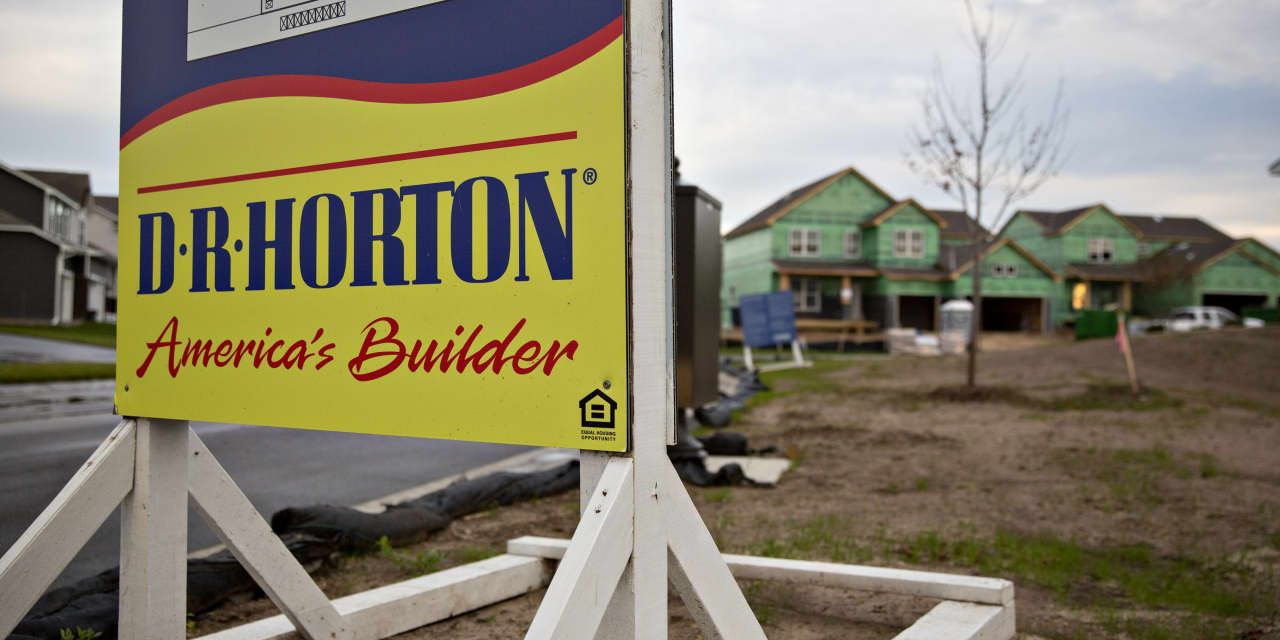Home-builder stocks trounced the broader market in 2023, fueled by buyers who flocked to new construction and the shift late in the year to a brighter housing outlook.
The housing business will rebound in 2024 as lower mortgage rates draw more buyers to the market, but builder stocks may already reflect a lot of the good news after 2023’s big gains. The 10 largest home builders by market capitalization jumped an average of 95% in 2023, while the
S&P 500
index was up 24%.
Builders of all sizes climbed in 2023. The smaller
M/I Homes
soared nearly 200%, followed by the larger
PulteGroup,
which gained 127%. Even the group’s laggards had a significant trajectory:
NVR
and
Lennar
were up 52% and 65%, respectively.
Builders earlier this year were helped by the lack of existing homes for sale. But a significant chunk of the stocks’ gains came in the past two months, as expectations for Federal Reserve interest-rate cuts rapidly brightened. The 10-year Treasury yield, with which mortgage rates often move, fell from just below 5% to a recent 3.8% in a matter of months. Mortgage rates, as a result, retreated to 6.6% at year’s end from almost 8% as recently as October, according to Freddie Mac.
Using the often-cited maxim for investing in home builders—buy at book value, sell at two-times book—the stocks are too expensive to buy but too cheap to sell. Excluding NVR, which trades at a much higher valuation than the rest of the group, the nation’s 10 largest builders were trading at a recent average of 1.4 times forward book value, according to FactSet.
The good news: Economists expect mortgage rates to continue to fall throughout 2024 as inflation eases. That, in turn, will cut down on sky-high homebuying costs, prompting buyers to return in greater force. With more demand, builders could sell more homes with fewer discounts.
Lennar,
one of the nation’s largest home builders, “will be well prepared” for pent-up demand if rates fall, Stuart Miller, the company’s executive chairman, said on a December earnings call. “Most recent movements in interest rates suggest a better road ahead,” he said.
The bad news: high expectations for the spring buying season are already priced into most of the stocks, analysts say. “The market is telling the Street that prospects are better than the Street thinks,” says BTIG analyst Carl Reichardt, who rates most of the group Hold.
Jay McCanless, a Wedbush analyst, lowered his ratings on a slate of builders and building-product companies to Neutral from Outperform precisely because the stock prices have baked in “a robust start” to 2024. “Our long-term bullish view on housing demand in the U.S. has not changed,” he wrote in a mid-December note.
Indeed, structural factors that made the sector attractive are in place for the long term: Aging Millennials, followed by Gen Zers, are looking to own homes while baby boomers are downsizing. There’s a general U.S. housing shortage, economists say, compounded by the need to eventually replace aging housing stock. And a fragmented and localized market means large public builders are better suited than private companies to gain market share, leveraging their scale to reduce costs.
“Home-building stocks can continue to generate strong shareholder returns over the next few years,” says Jeffrey Kolitch, who manages the $1.5 billion Baron Real Estate fund. Shares trade at lower price/earnings ratios than the broader S&P 500, he notes, and that’s even with changes to their businesses, such as controlling more land via options, that he says make the companies less cyclical than in the past.
For now, it’s a waiting game for investors. But an entry point could be coming. The market could be disappointed if the Fed doesn’t cut rates as many times as expected. That could send mortgage rates higher, and builder stocks lower, if expectations for a robust spring selling season appear too optimistic.
Investors should keep their eyes on the 10-year Treasury yield; its fluctuations drove big changes in builder stocks in 2023. The five biggest daily losses in the
iShares U.S. Home Construction
exchange-traded fund in 2023 accompanied gains in the yield, according to data form FactSet and Tradeweb ICE Closes. Mortgage rates don’t need to climb back to nearly 8% to shake home buyers and investors: ”The level of mortgage rates isn’t nearly as big of a headwind to demand as volatility is,” says McCanless.
The builders worth considering are some of the sector’s biggest names. Of the five most widely-covered builder stocks, analysts expect new orders to grow fastest at
Toll Brothers,
Lennar, and
D.R. Horton.
Analysts are broadly positive on these stocks, with the majority holding Buy ratings.
D.R. Horton and Lennar are among the stocks Reichardt prefers. “Local market share is a critical driver to returns,” he says. The bigger presence a company has in a local market, the better its cost advantage. “They’re able to provide homes to customers more affordably than many of their peers, and they’re able to do it at good margins because their costs are low,” he says.
Baron’s Kolitch says Toll Brothers, Lennar, and D.R. Horton “have dramatically improved” their balance sheets and their ability to generate strong, long-term earnings growth and cash flow and return capital to shareholders. His fund owns all three.
Kolitch adds that the three stocks deserve higher multiples. “There’s an argument for a paradigm shift in the valuation multiples higher because of many of these improvements. If they just grow their earnings, and then they get a bit of a bump in the valuation metric, they’re going to be very good stocks,” he says.
Write to Shaina Mishkin at [email protected]
Read the full article here




